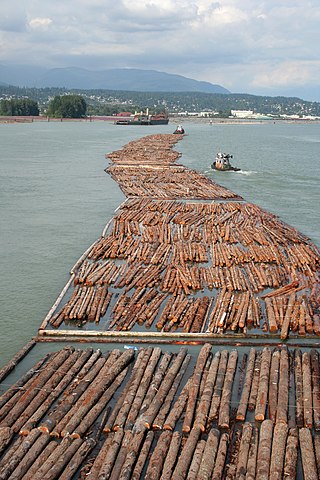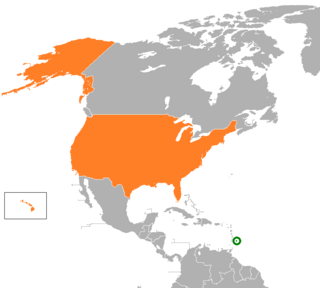The Caribbean Basin Initiative (CBI), a trade initiative initiated by the 1983 Caribbean Basin Economic Recovery Act (CBERA), is a United States program. The CBI came into effect on January 1, 1984, and aimed to provide several tariff and trade benefits to many Central American and Caribbean countries. Provisions in the CBERA prevented the United States from extending preferences to CBI countries that it judged to be contrary to its interests or that had expropriated American property.
The Caribbean Basin Economic Recovery Expansion Act of 1990, known as "CBI II", made the CBI permanent. However, once the United States entered into the North American Free Trade Agreement (NAFTA) in 1994 with Mexico it became easier for Mexico to export its products to the United States. CBI countries had lost their advantage relative to Mexico, a major competitor in industries such as textiles and apparel, so they sought to increase their own preferences and achieve "NAFTA parity". Those efforts were not successful until the 2000 Caribbean Basin Trade Partnership Act, which was broadened in 2002. Several exports from the region continue to receive preferential status in the United States, however those preferences will likely be replaced by bilateral free trade agreements, and possibly by the proposed Free Trade Area of the Americas.
In the early 1980's, Haiti was self-sufficient in the field of rice production. However, the CBI called for liberalizing Haiti's economy and re-allocating nearly one-third of domestic Haitian food production toward export crops, and as a result of the subsequent shrinking of the rice industry and inundation of the market with cheap imported rice subsidized by the US government, Haitian farmers found their livelihoods crippled as they could not compete with the subsidized "Miami rice". Subsequently, rice production in Haiti plummeted, and many rural Haitians employed throughout the rice industry lost their source of income. However, American rice producers that took in government subsidies and dumped their product on Haiti, where tariffs on rice imports shrank from 35% to 3%, benefited greatly financially. [1] [2] [3]

The North American Free Trade Agreement was an agreement signed by Canada, Mexico, and the United States that created a trilateral trade bloc in North America. The agreement came into force on January 1, 1994, and superseded the 1988 Canada–United States Free Trade Agreement between the United States and Canada. The NAFTA trade bloc formed one of the largest trade blocs in the world by gross domestic product.

The Free Trade Area of the Americas (FTAA) was a proposed agreement to eliminate or reduce the trade barriers among all countries in the Americas, excluding Cuba. Negotiations to establish the FTAA ended in failure, however, with all parties unable to reach an agreement by the 2005 deadline they had set for themselves.

An agricultural subsidy is a government incentive paid to agribusinesses, agricultural organizations and farms to supplement their income, manage the supply of agricultural commodities, and influence the cost and supply of such commodities.

The Canada–U.S. softwood lumber dispute is one of the largest and most enduring trade disputes between both nations. This conflict arose in 1982 and its effects are still seen today. British Columbia, the major Canadian exporter of softwood lumber to the United States, was most affected, reporting losses of 9,494 direct and indirect jobs between 2004 and 2009.
The Canada–United States Free Trade Agreement (CUSFTA), official name as the Free Trade Agreement between Canada and the United States of America, was a bilateral trade agreement reached by negotiators for Canada and the United States on October 4, 1987, and signed by the leaders of both countries on January 2, 1988. The agreement phased out a wide range of trade restrictions in stages, over a ten-year period, and resulted in a substantial increase in cross-border trade as an improvement to the last replaced trade deal. With the addition of Mexico in 1994, CUSFTA was superseded by the North American Free Trade Agreement (NAFTA).

The Dominican Republic–Central America–United States Free Trade Agreement is a free trade agreement. Originally, the agreement encompassed the United States and the Central American countries of Costa Rica, El Salvador, Guatemala, Honduras, and Nicaragua, and was called CAFTA. In 2004, the Dominican Republic joined the negotiations, and the agreement was renamed CAFTA-DR.
The Caribbean Basin Trade Partnership Act (CBTPA) is a law adopted by the U.S. Government in October 2000 to delineate enhanced trade preferences and eligibility requirements for the 24 beneficiary countries of the Caribbean Basin region.

The Caribbean Basin Trade Partnership Act (CBTPA) is a United States legislative act signed into law on May 18, 2000 by President Bill Clinton as part of the Trade and Development Act of 2000. This latter act, which also included the Africa Growth and Opportunity Act of 2000 (AGOA), was intended to advance U.S. economic and security interests by strengthening American relationships with other regions of the world then viewed to be making significant strides in terms of economic development and political reform.

The economy of North America comprises more than 596 million people in its 24 sovereign states and 15 dependent territories. It is marked by a sharp division between the predominantly English speaking countries of Canada and the United States, which are among the wealthiest and most developed nations in the world, and countries of Central America and the Caribbean in the former Latin America that are less developed. Mexico and Caribbean nations of the Commonwealth of Nations are between the economic extremes of the development of North America.
The Caribbean-Canada Trade Agreement known as ("CARIBCAN") is a Canadian government programme, established in 1986 by the Parliament of Canada. The agreement was created to promote trade, investment and provide industrial cooperation through the preferential access of duty-free goods from the countries of the Commonwealth-Caribbean to the Canadian market.

The United States and Barbados have had cordial bilateral relations since Barbados' independence in 1966. The United States has supported the government's efforts to expand the country's economic base and to provide a higher standard of living for its citizens. Barbados is a beneficiary of the U.S. Caribbean Basin Initiative. U.S. assistance is channeled primarily through multilateral agencies such as the Inter-American Development Bank and the World Bank, as well as the U.S. Agency for International Development (USAID) office in Bridgetown.

Haiti–United States relations are bilateral relations between Haiti and the United States. Succeeding U.S. presidents refused to recognize Haiti until Abraham Lincoln. The U.S. tried to establish a military base in Haiti and invaded. It withdrew in 1934 but continued to intervene in Haiti during subsequent decades.

The economy of Belize is a small, essentially private enterprise economy that is based primarily on agriculture, tourism, and services. The cultivation of newly discovered oil in the town of Spanish Lookout has presented new prospects and problems for this developing nation. Belize's primary exports are citrus, sugar, and bananas. Belize's trade deficit has been growing, mostly as a result of low export prices for sugar and bananas.

Agriculture in Guyana is dominated by sugar and rice production. Although once the chief industry, it has been overshadowed by mining.

Caribbean Basin Economic Recovery Act of 1983 (CBERA) — P.L. 98-67, Title II, authorized unilateral preferential trade and tax benefits for eligible Caribbean countries, including duty-free treatment of eligible products.
Rice production was an integral part of the Haitian economy, as it has been farmed in Haiti for over two hundred years. The origin of this rice has been traced back to West African agriculture. Rice is a staple food for most Haitians but it has become a commodity in the sense that Haiti is no longer self-sufficient in producing rice for the country. Haiti maintained dependency on their own agriculture of rice until the 1980s. In the mid-1980s Haiti was no longer producing substantial amounts of rice and by the 1990s Haiti held a greater reliance on imports rather than domestic rice production. The decline in rice production caused by policies under the Caribbean Basin Initiative had devastating consequences for Haiti's rural population. Many Haitian farmers, traders, and millers faced unemployment and relocation. Because farming was their livelihood, many could not find adequate work with their skill set. The Adoption of trade liberalization policies and environmental degradation are said to be the two factors that have caused Haiti's decline in rice production. These policies have lowered the rice import tariff so that it is now less than any other Caribbean nation. The tariff is at three percent, causing a dumping ground of rice in Haiti. Many accuse the United States of purposefully depositing all of their rice into Haiti. In 1985 the local rice production was at 163,296 metric tons while the US imports were only at 7,337 metric tons counting for a total of 170,663 metric tons. By 2000, local production had decreased to 130,000 metric tons while US imports ascended to 219,590 metric tons; in addition, since 1995 over $13 billion in subsidies have gone to rice exports. The result made Haiti inundated with subsidized rice imports while undercutting domestic production.

The sugar industry subsumes the production, processing and marketing of sugars. Globally, most sugar is extracted from sugar cane and sugar beet.

The North American Free Trade Agreement of 1994's effects on Mexico have long been overshadowed by the debate on the Agreement's effects on the economy of the United States. As a kind partner in the agreement, the effects that NAFTA has had on the Mexican economy is essential to understanding NAFTA on a whole. A key factor in this discussion is the way the Agreement was presented to Mexico; namely, that it would increase development of the Mexican economy by providing more middle class jobs that would enable more Mexicans to lift themselves out of the lower classes. Thus, wages, employment, attitudes, and migration all present essential areas of analyses to understand effects NAFTA has had on the Mexican economy.

Trump administration farmer bailouts are a series of United States bailout programs introduced during the presidency of Donald Trump as a consequence of his "America First" economic policy to help US farmers suffering due to the US-China trade war and trade disputes with European Union, Japan, Canada, Mexico, and others. China and respectively European reconcilable tariffs imposed on peanut butter, soybeans, orange juice, and other agriculture products had hit hard, especially swing states, such as Iowa, Ohio, and Wisconsin.